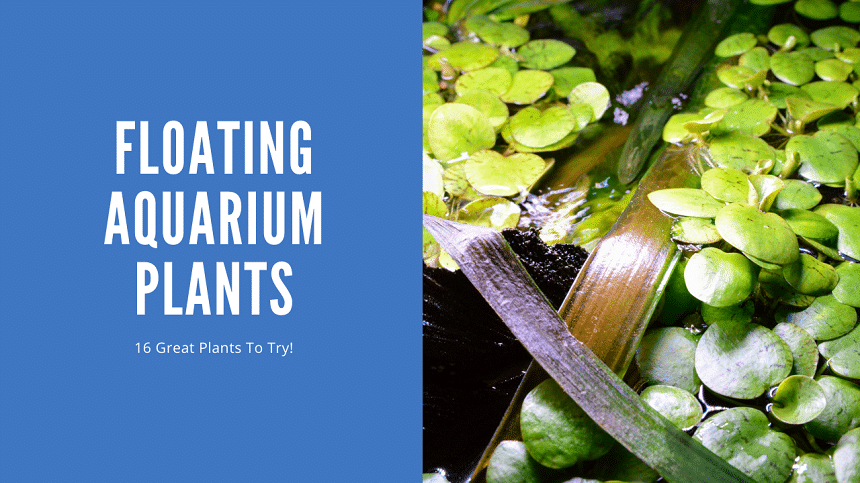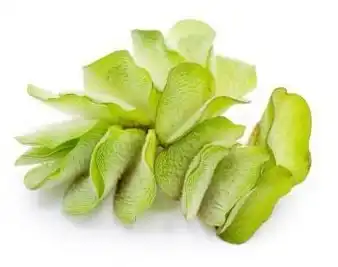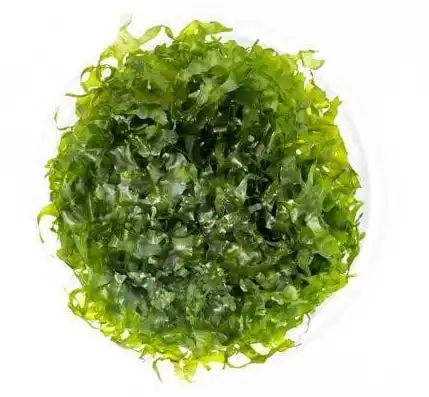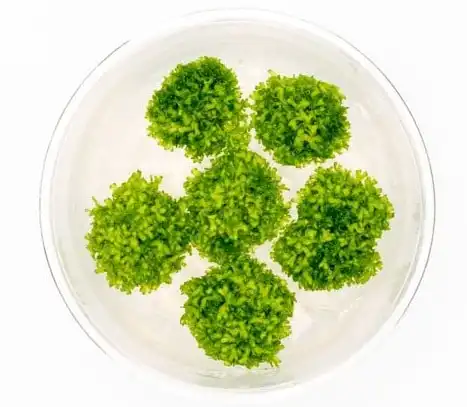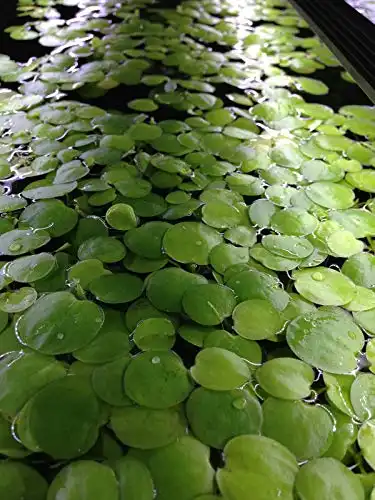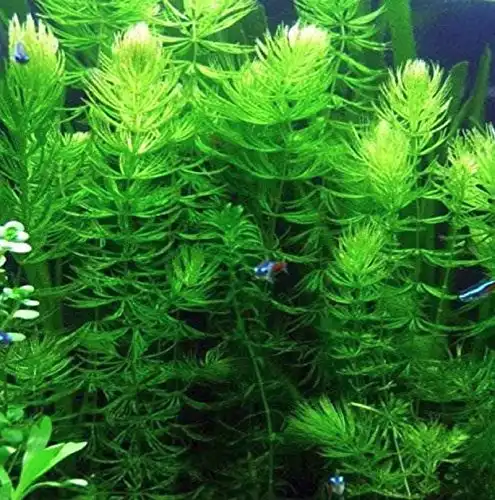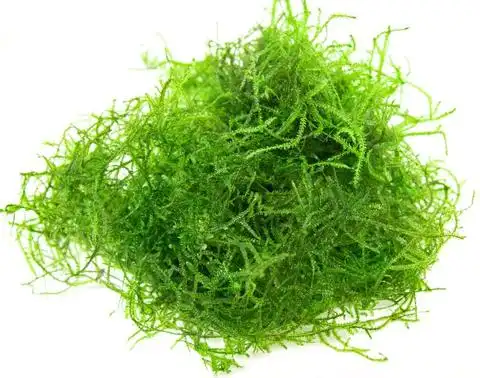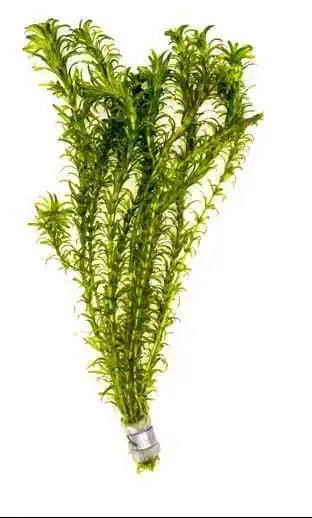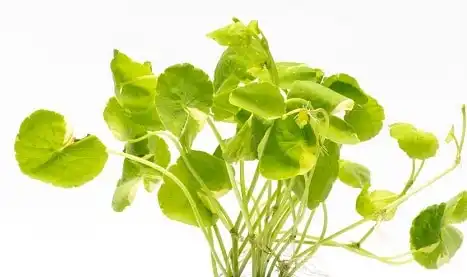Thank you for visiting! By the way… any links on this page that lead to products on Amazon and other stores/partners are affiliate links Aquarium Store Depot earns a commission if you make a purchase.
Do you have any floating plants in your freshwater aquarium? If not, you could be missing out on a whole new dimension for your planted aquarium.
Floating plants don’t only look great, they also provide some other amazing benefits. In this article, I’ll cover everything you need to know to get started growing floating plants and provide you with a list of amazing plant options. Let’s get started!
What Are Floating Aquarium Plants?
Floating aquarium plants come in many different shapes and sizes. When we talk about floating plants in the aquarium hobby, we don’t only mean aquatic plants that literally float on the water surface, with parts of the plant sticking out of the top of the water.
In addition, aquatic plants that are not rooted to the substrate, but drift freely in the water column are also included in this category. Most species are green overall, but some like the Red Root Floater have a bit more color.
The Benefits Of Floating Plants For Your Tank
Let’s face it, a lidless set up with floating aquarium plants looks amazing. This kind of setup creates such a fascinating and natural appeal that it’s almost impossible to walk past without staring.
Unfortunately in most tanks, the surface is covered by a hood, but of course, there are often practical reasons for having a lid! Many freshwater aquarium fish are strong jumpers and will end up on the floor if they are kept in a topless aquarium, so you need to think carefully for the safety of your livestock.
Floating plants look great from whichever side you’re looking at them, and those types that grow on the surface of the water usually have great root systems that hang down into the water, which looks really cool.
Oxygen & Food
Floating plants are very popular in smaller aquariums like betta fish tanks, shrimp tanks, and other nano setups. This is because they’re really helpful in keeping conditions stable and safe in the freshwater aquarium.
One of the benefits these aquatic plants provide is oxygen! Plants use carbon dioxide and give off oxygen, which is what your fish need to breathe. Since most floating plants are fast-growing, they are able to produce plenty of oxygen.
In addition, micro-organisms and other life forms grow on the roots and other plant surfaces. These provide a great food source, particularly for shrimp and fry.
Cover For Your Fish
Apart from good looks, floating plants have loads of benefits for your fish and inverts. Floating plants that create a lot of structure in the water column make great places for fish to lay their eggs, and for fish fry and baby shrimps to hide in, safely away from hungry mouths.
Species that have leaves that cover the water surface really help to bring out the best in many fish species. Fish feel safer and have lower stress levels under aquatic plant cover. This is because small fish have many predators that hunt them from above out in nature.
Nutrient And Algae Control
Most floating aquarium plants grow without rooting themselves in the substrate. This means they are very good at getting all the nutrients they need from the water column. This is good news because high nutrient levels in the water can be very harmful to your livestock, and also tends to result in loads of algae!
Beneficial bacteria are able to colonize the surfaces of the plant and this really helps with the aquarium cycling process. These bacteria convert harmful toxins in fish waste into nitrates that the plants use as food. In fact, when plants are soaking up the nitrates, the need for water changes is reduced a whole lot! That doesn’t mean you don’t need good aquarium filtration of course.
Removing nitrates from the water isn’t the only way that floating plants help to control algae. Floating plants that cover the water’s surface also block out light from above, and without light and nutrients, algae won’t grow.
Other freshwater aquarium plants that grow below your floating plants also need nutrients and light of course. This competition can be a big problem if you add floating plants after planting other plants in the tank, especially types that need a lot of light.
Now that you know more about the pros and cons of floating aquarium plants, it’s time for me to introduce you to the list of amazing species for your home aquarium!
The 16 Best For Freshwater Tanks
I’ve put together this amazing list of the most popular and effective floating plants that you can grow in your aquarium to make your choice a lot easier. I’ve included surface floaters like Amazon Frogbit that can cover the surface of your aquarium, as well as submerged plants like Water Sprite, that grow in the water column.
So let’s get started with our list and get to know the top 16! Check out our YouTube video from our channel above. We got you covered in more detail from our blog below!
In A Hurry? Check All The Best Floating Plants at BucePlant!
1. Red Root Floater
A great red floating plant that is easy to care for.
- Scientific Name: Phyllanthus fluitans
- Skill Level: Easy
- Lighting: Low-High
- Tank Placement: Surface
- Growth Rate: Fast
- CO2 Requirement: No
Red Root Floater is an amazing floating plant from South America that does well in just about any freshwater aquarium. The leaves of this plant are green if grown under low light, but turn a deep red with high lighting. These floating plants have awesome red roots, no matter what sort of lighting you use.
Red Root Floaters grow fast and will quickly cover the water surface of your fish tank. Controlling its growth is easy though. All you need to do is pull out a few plants every now and then. This is one of the best floating aquarium plants if you want to add reds to your aquarium.
2. Fern
A floating plant that tolerates cold water. Does best in low flow tanks
- Scientific Name: Salvinia natans
- Skill Level: Easy
- Lighting: Low-High
- Tank Placement: Surface
- Growth Rate: Fast
- CO2 Requirement: No
Salvinia natans is a really cool floating freshwater plant option for aquariums with lower water temperatures. This low-maintenance plant species has green, air-filled leaves with interesting, hair-like structures on their top surface.
The leaves of this plant can measure a little over an inch in size but are usually smaller in the home aquarium. These aquatic plants don’t have a very large root system and will grow best in low-flow tanks.
3. Dwarf Water Lettuce
A popular floating plant that is used in ponds and aquariums!
- Scientific Name: Pistia stratiotes
- Skill Level: Easy
- Lighting: Low-High
- Tank Placement: Surface
- Growth Rate: Fast
- CO2 Requirement: No
Dwarf Water Lettuce is a green floating plant that is native to Lake Victoria in East Africa. The leaves of the Dwarf Water Lettuce plant grow about 1.5 inches long and are soft and velvety in texture.
Dwarf Water lettuce plants grow dense roots that trail down into the fish tank, providing great places for shrimp and small fish to hide. Its well-developed roots also make Dwarf Water Lettuce a great aquatic plant for reducing nitrate levels in fish tanks.
4. Salvinia cucullata
A unique and unknown floating plant in the aquarium hobby. Well worth looking into!
- Scientific Name: Salvinia cucullata
- Skill Level: Easy
- Lighting: Low-High
- Tank Placement: Surface
- Growth Rate: Fast
- CO2 Requirement: No
This interesting floating plant is native to the tropical regions of Asia. It is a floating fern that is not very well known in the hobby but makes an excellent addition to the planted fish tank.
The leaves of this aquarium plant are less than half an inch in size and, under ideal conditions, curl upwards to form an interesting bag shape. Achieving this form in the planted aquarium, however, requires good light, plenty of nutrients, and still water conditions.
5. Subwassertang
A floating plant that is great for shrimp tanks.
- Scientific Name: Lomariopsis lineata
- Skill Level: Moderate
- Lighting: Low-Medium
- Tank Placement: Submerged Floating
- Growth Rate: Low-Moderate
- CO2 Requirement: Recommended
Subwassertang (or Susswassertang) is a German name that translates to English as ‘freshwater seaweed’. This is a really interesting species of plant that not that much is known about. In fact, the leaves of this floating plant are just one cell thick!
Subwassertang floats freely in the aquarium and does not produce roots or need any substrate to grow. This is a plant that is very popular with shrimp keepers.
6. Crystalwort Riccia
Originally made popular by Takashi Amano himself, this floating plant grows great floating or attached to driftwood.
- Scientific Name: Riccia fluitans
- Skill Level: Easy
- Lighting: Low-Moderate
- Tank Placement: Submerged Floating, Attached To Hardscape
- Growth Rate: Moderate
- CO2 Requirement: Recommended
If left to grow naturally, Riccia fluitans will form a mat at the surface of the aquarium. It is a versatile floating plant that can also be grown attached to hardscape features or attached to mesh though.
This beautiful species of plant can be found growing all over the world. It provides great habitat for small fry and shrimps in your aquarium.
7. Banana Plant
A unique looking plant that can be used floating or attached to hardscape.
- Scientific Name: Nymphoides aquatica
- Skill Level: Easy
- Lighting: Moderate-High
- Tank Placement: Midground or Foreground
- Growth Rate: Moderate
- CO2 Requirement: No
The Banana Plant is native to the Southeastern United States. This low maintenance aquatic plant does send roots into the substrate, and can be rooted and allowed to grow to the surface, or left to float and send roots down. These are beautiful and interesting water lily-type plants that can flower if given good light and left to grow mature.
8. Mosaic Plant
A unique blooming species that makes an excellent floating plant.
- Scientific Name: Ludwigia sedioides
- Skill Level: Advanced
- Lighting: High
- Tank Placement: Midground
- Growth Rate: Slow-Moderate
- CO2 Requirement: No
The Mosaic plant is a truly spectacular floating plant. The leaves of this plant are dark green with red edges and close up each night before reopening when the sun rises.
Unfortunately, this plant requires some space and needs to be planted in ponds or larger freshwater aquariums to grow to its full size and glory. This plant produces plenty of beautiful yellow flowers when it is growing well.
9. Duckweed
- Scientific Name: Lemna minor
- Skill Level: Easy
- Lighting: Moderate-High
- Tank Placement: Surface
- Growth Rate: Fast
- CO2 Requirement: No
Duckweed is a very small floating plant that reproduces quickly in the aquarium. This tough floating plant is very efficient for removing nitrates from the water.
Each plant is bright green and floats above the water surface with small hanging roots. Aquarists have a love/hate relationship with this plant because of its great looks and nano-size, but aggressive growth.
10. Amazon Frogbit
A fast growing floating plant. Known to be invasive in North America. Handle with care!
- Scientific Name: Limnobium Laeviatum
- Skill Level: Easy
- Lighting: Moderate
- Tank Placement: Surface
- Growth Rate: Fast
- CO2 Requirement: No
Amazon Frogbit is a very popular South and Central American floating plant option that can be grown on the water surface of the planted aquarium. The spongy leaves of this plant can be left to cover the surface of your aquarium and the hanging roots provide great habitat for your fish and livestock.
Fortunately, Amazon Frogbit is low maintenance and pretty easy to control because the plants are not super small. This plant has become an invasive weed in parts of North America, so remember to be careful about disposing of it.
11. Hornwort
Easy to maintain and grows large. Invasive in North America.
- Scientific Name: Ceratophyllum demersum
- Skill Level: Easy
- Lighting: Moderate-High
- Tank Placement: Submerged Floating
- Growth Rate: Moderate-Fast
- CO2 Requirement: No
Hornwort is a very popular and very easy-to-grow aquarium plant. This stem plant lacks true roots and is not rooted in the substrate.
It will float in the aquarium, providing great cover for small fish and shrimps. This makes the Hornwort plant a popular choice for breeders who keep grow-out tanks without substrate.
12. Java Moss
One of the easiest mosses to grow in an aquarium. Great for small fish and shrimp
- Scientific Name: Vesicularia dubyana
- Skill Level: Easy
- Lighting: Low-Moderate
- Tank Placement: Submerged Floating, Attached, Carpet, Walls
- Growth Rate: Moderate
- CO2 Requirement: Recommended
Java Moss is one of the most versatile, and popular aquatic plants in the hobby. These low-maintenance plants do not require any special lighting or equipment and can be used in all sorts of different ways.
Like most floating plants, Java Moss is really useful for protecting eggs and creating a hiding place for small fry, and shrimps from hungry bigger fish.
13. Water Wisteria
An easy to grow and great beginner floating plant to try!
- Scientific Name: Hygrophila difformis
- Skill Level: Easy
- Lighting: Low-Moderate
- Tank Placement: Submerged Floating, Rooted In Midground/Background
- Growth Rate: Fast
- CO2 Requirement: No
Water Wisteria is a very easy and fast-growing plant that is a great choice for beginners because it does not need CO2 or strong light. It is quite similar to the Water Sprite and the two plants are sometimes confused.
The leaves of this plant look quite different in their emersed form and really change shape when grown underwater. The Water Wisteria plant can be rooted in the substrate, or simply floated in the aquarium.
14. Anacharis
Excellent as a food source and sucks up nutrients in an aquarium. One of the easiest freshwater plants to care for
- Scientific Name: Egeria densa
- Skill Level: Easy
- Lighting: Low-Moderate
- Tank Placement: Submerged Floating, Rooted In Midground/Background
- Growth Rate: Moderate-Fast
- CO2 Requirement: No
Anacharis is another easy stem plant for beginners that can be grown floating in the aquarium, or rooted in the substrate. The Anacharis plant grows very well in cool water and cooler tropical aquariums.
Anacharis is a fairly fast-growing and hardy plant, that can grow to a large size. It is best to grow this plant in medium to large aquariums so that it doesn’t take over a nano aquarium. It is one of the best floating aquarium plants for beginners.
15. Water Sprite
Readily available and easy to grow. This fast growing plant will soak up nutrients and thrive in low light
- Scientific Name: Ceratopteris thalictroides
- Skill Level: Easy
- Lighting: Moderate
- Tank Placement: Submerged Floating, Rooted In Midground/Background
- Growth Rate: Fast
- CO2 Requirement: No
Water Sprite is a great floating stem plant that grows wild in tropical areas all around the world. It is suitable for beginners and is easy to grow, providing many great benefits in the home aquarium. This aquarium plant can be left to float in the water or grow rooted in the substrate.
16. Brazilian Pennywort
A floating plant that can also grow rooted. Easy to grow and maintain
- Scientific Name: Hydrocotyle leucocephala
- Skill Level: Moderate
- Lighting: Medium
- Tank Placement: Foreground, Midground, Background, Submerged Floating
- Growth Rate: Moderate-fast
- CO2 Requirement: Yes
Brazilian Pennywort is a great South and Central American plant that is easy to grow and doesn’t need much maintenance. Although this plant will grow best under moderate lighting, it can adapt to low light conditions and a wide range of temperatures. This floating stem plant can be grown rooted or allowed to float freely in the fish tank.
Tank Setup
Floating plants are easy to grow, but do have a few special needs. For most of the species in this list, a substrate is not necessary, and that means these plants are ideal for aquarists who want the benefits of a planted fish tank, without substrate and hardscape.
Let’s take a closer look at how to set up your aquarium for these awesome aquatic plants.
Going Lidless/Hoodless
Plants that grow above the top of the water usually don’t do very well in the extreme humidity that occurs above the surface if you keep a hood on your tank. It is possible to grow a surface floating plant type with a hood but to really appreciate these plants, you’ll want to view them from above anyway.
This means you’ll want to set up your tank without a lid (aka Rimless Tank). You’ll need to be very careful about the kinds of fish you keep in a lidless aquarium of course because many fish will jump right out.
If you already have active fish and still want to grow floating plants without a lid, you may have to consider fitting some sort of screen over the top.
Lighting
Without a hood over your aquarium, you will need an alternative way to set up your lighting. Fortunately, there are plenty of different lighting options that can be used.
Clip-on lights are one of the best systems, but hanging fixtures, LED strips, and even desk lamp-style options will work.
Selecting The Right Filter
Even though floating plants are amazing for soaking up nutrients and improving water quality, a good quality filter is still essential. Most floating plants grow best in still water conditions so a fish tank with a low flow is definitely recommended. This means choosing the right filter can be very important.
Surface skimming filters are definitely not recommended for surface-growing plants. Choosing the right kind of filter is also very important when growing unrooted plants that drift in the water.
This is because these plants are delicate and the leaves and stems tend to break up and get sucked into filters, causing a blockage. The best way to avoid this is to use a sponge filter or to cover the intake of your power filter with a pre-filter sponge. If you are running a power filter, try using hardscape features like rocks and driftwood to break up the current.
Care and Instructions
Growing floating plants in your freshwater tank is very easy, and something that any aquarist can do. Let’s take a look at the most important aspects of floating plant care:
Feeding
Floating plants are water column feeders, and they can get most or all of the nutrients they need from fish waste and uneaten food in the fish tank. If you don’t have fish, or just want to get the best growth rate out of your plants, providing a liquid supplement, like APT Complete is definitely recommended.
CO2 Injection
Most floating plants don’t need high-tech conditions. A plant like Amazon Frogbit that floats on the surface of the aquarium has unlimited access to CO2 from the atmosphere around it. Floating plant species like Java Moss that grow beneath the surface are not so lucky, and many of them will benefit from added carbon dioxide.
Propagation
Floating plants are some of the easiest plants to propagate in the home aquarium. Although the flowering species can reproduce by seed, most species are very easy to grow by division.
The mother plant will often produce small plantlets that can be separated or allowed to detach themselves and continue to grow. Stem plants and mosses can simply be divided and allowed to float.
Tank Maintenance
Tank maintenance is a very important part of keeping a healthy aquarium. Many species of floating plant will thrive in high nutrient systems and can be very helpful in improving water conditions.
In heavily planted tanks, almost all of the nitrates in the water can be used by the plants, but I would still recommend you make regular partial water changes. It is important to test your water regularly to keep an eye on these parameters, so make sure you pick up a liquid test kit and test for nitrates when you’re changing water.
Heavily planted tanks will usually have very little algae growth, but keeping the substrate or floor of the tank clean with your gravel vac is still very important.
Keeping Them In Check
In many cases, these aquarium plants grow really fast and multiply quickly in a fish tank. This means they can fill up your aquarium, or completely cover up the water surface in no time at all.
Small floating plants that multiply can be pulled out of the tank very easily, but you might have to do this a few times a month. Some species, like Duckweed, can multiply incredibly fast, and this will keep you quite busy.
Many aquarists use floating rings to keep surface-growing plants from covering certain areas. This is a great way to keep your plants from shading out the other plants below.
Tank Mates
Floating plants can be so effective in controlling algae in the planted aquarium, that they cut out the food source for algae-eating animals. Fortunately, algae wafers can be used to feed your algae eaters, but generally speaking, you should avoid growing a lot of floating aquarium plants if you keep animals like:
If you plan on keeping your tank without a hood, you’re going to need to consider the safety of your fish, and avoid keeping species that are known for jumping. Unfortunately, most freshwater fish can easily jump out of lidless tanks so this is always a risk.
Pests and other problems
Being such fast-growing plants, it’s really important that you dispose of unwanted plants very carefully. Many floating plants will turn into an invasive weed and really take off if they get into your local waterways, posing a real threat to native plants and animals.
Small species like the water fern and duckweed can be pretty messy and will tend to stick to your arms and equipment during tank maintenance.
Snails and other organisms very often hitch a ride into your fish tank when adding new floating plants. For this reason, I would definitely advise you to buy tissue culture specimens wherever possible because they are grown under sterile lab conditions. You can learn more about tissue culture plants from the video by Utah State University below.
Where To Buy Floating Plants
Floating plants are very popular in the hobby and can usually be picked up from your local fish-keeping store. I prefer to buy from trusted online retailers because they tend to have the best range of species and tissue cultures.
FAQS
Do they oxygenate the water?
Floating plants work great to oxygenate the water in your aquarium. This is important for keeping your livestock healthy and active.
Do they stop algae?
One of the greatest benefits of floating plants is their ability to soak up excess nutrients in the aquarium water. This, coupled with the shading they provide, makes them a great way of reducing algae in your aquarium!
Do they plants need CO2?
Most of the popular floating plants for aquariums can grow fine without injected CO2. Increasing CO2 levels (to 30 ppm) will improve growth rates though.
Will floating plants block light?
Floating plants are often fast-growing and can block out light to other plants growing below them. Low-light plants will grow just fine below floating plants but high-light species will be difficult to care for.
Can you have too many in an aquarium?
Allowing floating plants to cover the surface of your tank can look great and create an excellent habitat for your fish and livestock. It can cause some problems, however, like making tank maintenance and feeding fish more difficult, and blocking out light to submerged plants
Final Thoughts
Floating plants on the top of a planted tank, or hanging in the water column can make an already great-looking aquarium look truly spectacular! They also happen to offer loads of important benefits for your fish and other livestock.
That’s enough reason for anyone to try growing this kind of freshwater plant. So why not go ahead and try something new in your aquarium today?
- About the Author
- Latest Posts
I’m thrilled that you found Aquarium Store Depot! Here you’ll find information on fish, aquariums, and all things aquatics related. I’m a hobbyist (being doing this since I was 11) and here to help other hobbyists thrive with their aquariums! I adhere to a high quality Editorial Process and Review products with real life field usage and practical analysis.

